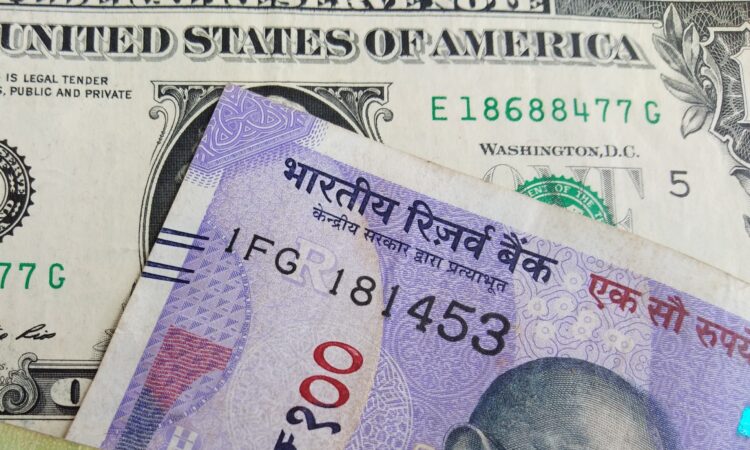
Currency traders in the India’s foreign exchange market are choosing exotic option trades in the dollar-rupee pair amid the Reserve Bank of India’s aggressive intervention to keep the rupee stable, according to four foreign currency traders who spoke to NDTV Profit anonymously.
This lucrative, but riskier, trade play is likely to burn a hole in market players’ pockets if the rupee comes under pressure, they added.
Indian rupee has been trading in a narrow range of 83.25-83.40 a dollar over the last four months on account of the central bank’s active two-sided intervention in the forex market.
A lack of significant trading opportunities in the spot market has turned currency traders to exotic foreign exchange options trading to make money, according to the traders quoted above. The build-up of such risk, if any external shock arises in the future, will result in hefty monetary losses, they added.
Exotic options are options contracts that differ from traditional options in their payment structures, expiration dates, and strike prices. These options can be customised to meet the risk tolerance and desired profit of the investor.
Although exotic options provide flexibility, they do not guarantee profit.
Options currently at play include knock-in and knock-out trades. These are options which get activated or expire whenever the rupee reaches a specific level against the dollar.
On the National Stock Exchange, the open interest on most-active options expiring on Dec. 29 at the strike price of 83.25 stood at 6.23 lakh contracts on Friday. According to the trader mentioned above, any level above 3 lakh contracts is considered high interest. NSE accounts for the highest volume of currency futures and options trading.
Some banks are selling call options on the dollar-rupee currency pair as the volatility in the spot rupee in 2023 has been lower than the implied volatility for options, a senior forex trader with a large private bank said, speaking anonymously.
On Friday, the rupee closed at 83.21 against the dollar, ensuring that the option sellers made a profit.
Aggressive Intervention
The RBI has turned the market players somewhat complacent through its aggressive interventions over the last few months. Thus they are encouraged to indulge into trades where the risk is negligible and they can pocket the premium without incurring losses, the private bank trader quoted above said.
The risk is building up, this person added.
Vikas Bajaj, head of currency derivatives at Kotak Securities, echoes this view.
“On the face of things, it may not be an alarming situation so long as volatility is well contained and yield chasing positions are in shorter tenors but things can turn bad, if for some reason volatility makes a sharp come back, and there is a vol (volatility) squeeze,” Bajaj said.
Market players do not expect the rupee to fall beyond 83.75 a dollar in the near-term.
In October, RBI bought $36.7 billion and sold $36.9 billion in the spot market, according to the central bank’s latest monthly bulletin. RBI had an outstanding currency futures position of $4.2 billion in October, the data showed.
Since then, the central bank’s headline forex reserves, which do not factor in the forward book, have swelled up by $29 billion to $615 billion in December.
While the RBI’s forex interventions is aimed at curbing sharp volatility in the exchange rate, the continued forex operations is to ensure a strong buffer as “foreign currency reserves are the first line of defense,” according to Dhiraj Nim, economist at ANZ Research.
“It is very clear that they want to optically keep the reserve number decent,” Nim said. “This means that they don’t want to run down a lot of their spot reserves, in case there is a sell-off pressure on the the rupee.”
“Secondly, the whole suite of intervention, whether it’s by spot, forward or futures in India, is to manage market expectations and have a check on domestic liquidity,” he added.
These spot dollar sales were followed by a similar intervention in the dollar-rupee forward market, to nullify the impact on systemic liquidity that is already running into deficit. According to RBI data, system liquidity is at Rs 2.68 lakh crore deficit, as of Thursday.
Emerging Threats
Simmering tensions in the Middle East and recent attacks in the Red Sea have brought back concerns of a rise in crude oil prices to the fore. This is likely to result in a pressure on the rupee in the future if the Brent crude oil prices surge to near $100 per barrel, the traders quoted above said.
Brent crude futures on the Intercontinental Exchange traded at $79.63 a barrel on Thursday, compared to $79.54 per barrel on Wednesday. Brent Crude hit a low of $73.52 on Dec 12, before the Red Sea attacks by Houthi rebels last week.
Geopolitical uncertainties along with an aggressive rate hike cycle by the US Federal Reserve in 2023 led RBI to conducting large forex intervention through spot, forward and futures market, the people quoted above said.
Owing to the swap transactions, RBI’s forward book turned negative in October to $14.6 billion. This means that the central bank is required to sell this amount at a later date.
By that calculation, RBI’s forex reserves are essentially at $600 billion after accounting for the net forward sales positions held by the central bank. Analysts expect the markets regulator to employ its three-pronged approach next year as well — mopping up dollar inflows, keeping the rupee stable, and strengthening its foreign currency coffers.
The fact that the Indian rupee is overd against the US dollar, even among its Asian peers, makes room for the RBI to continue its dollar purchases going ahead, the traders said.
